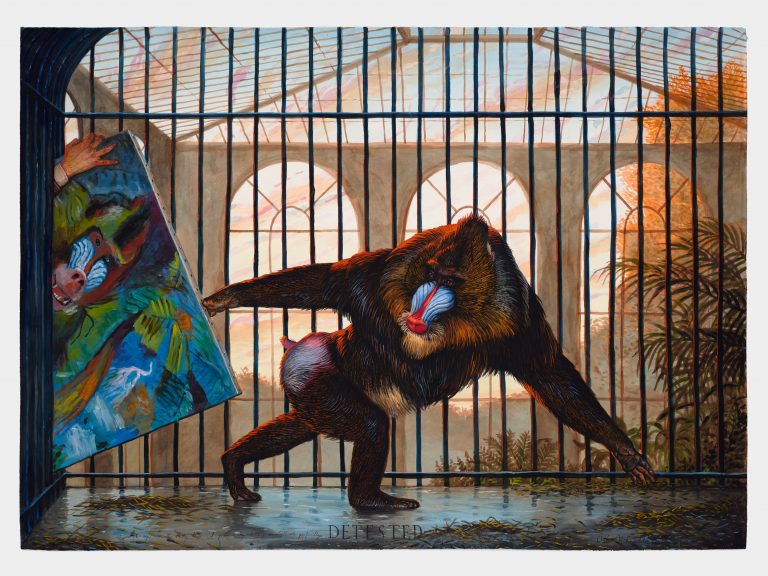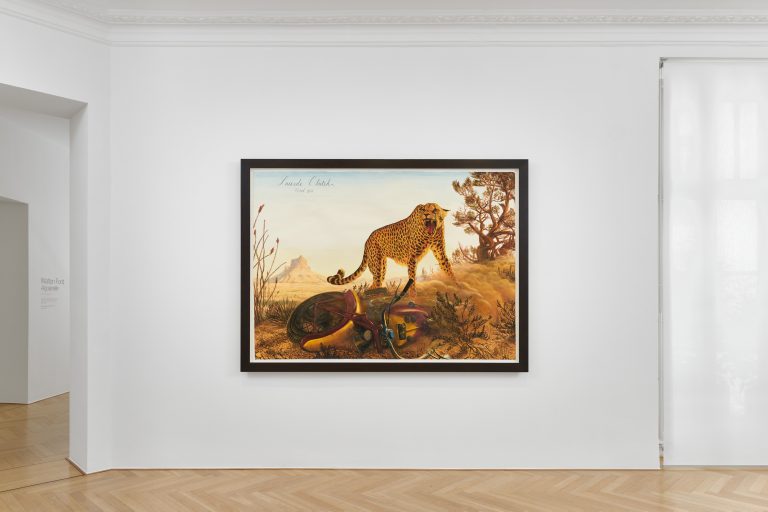Albert Oehlen
unverständliche braune Bilder

Albert Oehlen, u.b.B. 13, 2021. Courtesy of the artist and Galerie Max Hetzler, Berlin | Paris | London © Albert Oehlen. Photo: def image
Galerie Max Hetzler is pleased to announce unverständliche braune Bilder, a solo exhibition of new paintings by Albert Oehlen on view at two of its Berlin locations, Goethestraße 2/3 and Bleibtreustraße 15/16, coinciding with Gallery Weekend Berlin.
One of the most respected painters today, Albert Oehlen has been questioning the methods and means of painting since the 1980s, raising a sense of awareness of the medium, which he aims to reinvent and to reshape, always in opposition to traditional hierarchies.
Featuring twenty new works, grouped by the prefixes u.b.B. (unverständliche braune Bilder) and Ö-Norm, the paintings on view at Galerie Max Hetzler are works on canvas, with one painted on aluminium Dibond. As the title, ‘incomprehensible brown pictures’, suggests, earthy pigments predominate, evoking the colours of Cubism, or of artists painting at the time, such as Francis Picabia. Yet many other colours feature too, ranging from vibrant pinks and primaries to greens, greys and ethereal washes of sky blue. Many of the paintings contain white within them, bringing depth to the works and a luminosity to the show.
Techniques abound, from heavy dripping, spraying and smearing to delicate washes of rag-blur or sfumato, demonstrating the artist’s unrestrained approach to painting. Caught between flatness and depth, structure and formlessness, the works contrast areas of painterly intricacy with expressive sabotage, revealing an inimitable range of paint handling techniques, unique to the artist.
Oehlen produced his first abstract paintings in the late 1980s, with iconoclastic intent, in the hope of denouncing the inadequacy of painting; by the early 1990s, his paintings were incorporating ambiguous shapes and flashes of colour, that have since become a hallmark of his oeuvre. Whilst the u.b.B. works share similarities with these earlier abstractions, which he described at the time as ‘post-non-representational’, they contain far less impasto, appearing more subtle and smooth, with hazy, transparent layers yielding further ambiguities. In some works, carefully painted details contrast with sparse, unpainted areas, peppered with paint, evoking the dynamism of action painting, whilst in others, the back of a figure is suggested, with long hair and arms raised.
The continued importance of the line in Oehlen’s oeuvre can be traced throughout the exhibition, appearing at once curvy and controlled, freehand and stencilled.
In the Ö-Norm paintings, we are reminded of the often-eccentric lines found in the artist’s ‘Tree Paintings’, which likewise stretch freely to the edges of their supports. In the first painting from this group, a grid remains visible in the background, endowing it with a rough, unfinished quality, which accentuates a further tension in Oehlen’s work, between elegance and abjection.
The artist has repeatedly produced bodies of work that utilise the methods and aesthetics of collage, by combining such materials as advertising posters or printed fabric, with transparent veils of overpainting. Three of the paintings on view incorporate old exhibition posters, cut-out images and fragments of text, evoking his earlier ‘Billboard Paintings’, whilst also continuing to ridicule the abstract/figurative dualism.
In this way, the new works remix motifs and techniques from the artist’s iconoclastic practice, whilst also pushing in new directions with surface, colour and line, cementing Oehlen’s reputation for subverting the conventions of the medium. Here, painting is presented as an area of heterogeneity and tension, in which the possibilities and value of self-expression, artistic authenticity, and even, the act of painting itself, undergo relentless re-assessment.

Albert Oehlen, Ö-Norm 1, 2020. Courtesy of the artist and Galerie Max Hetzler, Berlin | Paris | London © Albert Oehlen. Photo: def image
Albert Oehlen (*1954, Krefeld), lives and works in Switzerland. Since 1981, he has been exhibiting regularly at Galerie Max Hetzler. Oehlen’s work has been shown in numerous solo exhibitions in international institutions, such as the Serpentine Gallery, London (2019–2020); Palazzo Grassi, Veniceand Aïshti Foundation, Beirut (2018–2019); Museo Nacional de Bellas Artes, Havana (2017); The Cleveland Museum of Art and Guggenheim, Bilbao (2016); New Museum, New York and Kunsthalle Zürich (2015); Museum Wiesbaden (2014); mumok, Vienna (2013); Kunstmuseum Bonn (2012); Carré d’Art de Nîmes (2011); Musée d’art moderne de la Ville de Paris (2009); Whitechapel Gallery, London (2006); MOCA, Miami and Kunsthalle Nürnberg, Nuremberg (2005); Musée Cantonal Des Beaux Arts, Lausanne, Domus Artium 2002, Salamanca and Secession, Vienna (2004), among others. Oehlen’s work is in the collections of the Museum Brandhorst, Munich; The Broad, Los Angeles; Centre Pompidou, Paris; The Cleveland Museum of Art, Cleveland; Fondation Louis Vuitton, Paris; Institut Valencià d’Art Modern, Valencia; Los Angeles County Museum of Art, Los Angeles; MUDAM, Luxembourg; Musée d’art moderne de la Ville de Paris, Paris; Musée d’Art Moderne et Contemporain Strasbourg; Museum of Contemporary Art, Chicago; Museum of Contemporary Art – MOCA, Los Angeles; Museum für Moderne Kunst, Frankfurt/Main; Museum Ludwig, Cologne; Tate, London; Staatliche Kunstsammlung Dresden; and The Museum of Modern Art, New York, among others.

Albert Oehlen, unverständliche braune Bilder, Galerie Max Hetzler, Berlin, April – August 2021. Courtesy of the artist and Galerie Max Hetzler, Berlin | Paris | London © Albert Oehlen. Photo: def image

Albert Oehlen, unverständliche braune Bilder, Galerie Max Hetzler, Berlin, April – August 2021. Courtesy of the artist and Galerie Max Hetzler, Berlin | Paris | London © Albert Oehlen. Photo: def image
Walton Ford
Aquarelle

Walton Ford, Detested, 2020. Courtesy of the artist and Galerie Max Hetzler, Berlin | Paris | London © Walton Ford. Photo: Tom Powel Imaging
Galerie Max Hetzler is pleased to announce Aquarelle, a solo exhibition of recent works by Walton Ford at Bleibtreustraße 45, Berlin. This is the artist’s first solo presentation with the gallery.
Ford is known for his monumental and extremely detailed watercolours depicting wild animals. His works expand upon the visual language and narrative scope of traditional natural history painting. Influenced by historical sources such as the illustrations of John James Audubon (1785-1851), who gained popularity with his life-sized drawings of birds, the artist creates works of a unique luminosity in watercolour, gouache, and ink.
Drawing from a variety of sources, including scientific illustrations, historical events, underground comics, literature, films, and myths, he creates unique, surreal stories with a spark of black humour.
“When I read a story that gives me an idea for a picture,” he explains, “I try to bring elements to the painting that are not contained in the text, so there’s a visual dimension to it you could never find elsewhere.”
Ford’s masterfully precise way of working presents minutely detailed renderings of individual species and their behavioural patterns, and foregrounds the cultural-historical encounter between animals and humans as well.
Many of the works on view at Galerie Max Hetzler powerfully reflect on bizarre and often violent encounters between humans and wildlife, and their consequences. Although animals such as monkeys, felines, wolves, bears, and birds are undoubtedly the main protagonists in the artist’s works, and human figures rarely appear, their presence is always implied.
In the work Suicide Clutch, 2021, a motorcycle has been attacked by a large, snarling cheetah, suggesting a near-fatal encounter between man and beast. In The Flaming Fields, 2020, Mount Vesuvius dramatically spits clouds of fire and ash in the background, illuminating the night sky, whilst Sir William Hamilton’s pet monkey climbs a classical marble sculpture on the overlooking balcony. Relics of human achievement, such as a magnifying glass, telescope, and a notebook, are arranged in a manner reminiscent of a vanitas still life. In Detested, 2020, Ford portrays a mandrill in a tug-of-war with Oskar Kokoshka (1886-1980) and the artist’s painting of the primate, commenting on the grandiose egotism of artists. Other works such as Threnos, 2020 and MORGUNDÖGG, 2020 draw strongly from ancient mythology, reflecting on man’s history with—and deepest instincts towards—animals, with attitudes alternating between fear and awe.
In this way, Ford creates an exotic cosmos of spectacular man-made stories. In dazzling colours, his works reveal a fragile alliance between civilisation and wilderness, beauty and brutality.
Walton Ford (*1960) lives and works in New York. Solo exhibitions of his work have been held in international institutions, such as Musée de la Chasse et de la Nature, Paris (2015); Hamburger Bahnhof Museum fur Gegenwart, Berlin; Albertina, Vienna; and Louisiana Museum of Modern Art, Humlebaek (2010–2011); Norton Museum of Art, West Palm Beach; San Antonio Museum of Art, San Antonio; and Brooklyn Museum, New York (2006–2007). Ford’s work is in the collections of the Albertina Museum, Vienna; Bowdoin College Museum of Art, Brunswick; Crystal Bridges Museum of American Art, Bentonville; Museum of Fine Arts, Houston; Museum of Modern Art, New York; New Britain Museum of American Art, New Britain; Princeton Art Museum, Princeton; Smithsonian American Art Museum, Washington D.C; Wadsworth Atheneum, Hartford; and Whitney Museum of American Art, New York, among others.


Walton Ford, Aquarelle, Galerie Max Hetzler, Berlin, 18 June – 14 August 2021. Courtesy of the artist and Galerie Max Hetzler, Berlin | Paris | London © Walton Ford. Photo: def image

Walton Ford, Aquarelle, Galerie Max Hetzler, Berlin, 18 June – 14 August 2021. Courtesy of the artist and Galerie Max Hetzler, Berlin | Paris | London © Walton Ford. Photo: def image

Walton Ford, Aquarelle, Galerie Max Hetzler, Berlin, 18 June – 14 August 2021. Courtesy of the artist and Galerie Max Hetzler, Berlin | Paris | London © Walton Ford. Photo: def image

Walton Ford, Aquarelle, Galerie Max Hetzler, Berlin, 18 June – 14 August 2021. Courtesy of the artist and Galerie Max Hetzler, Berlin | Paris | London © Walton Ford. Photo: def image
